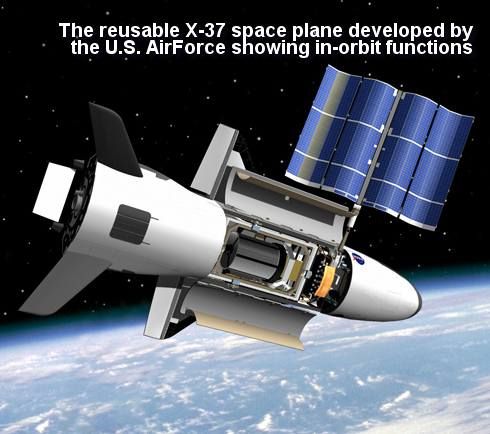
Posted on 04/28/2010 8:30:06 PM PDT by ErnstStavroBlofeld
The U.S. Air Force on April 22 launched a winged spacecraft designed to conduct military experiments on orbit for as long as nine months before re-entering the atmosphere and gliding to a runway landing in California.
The service hopes the unmanned X-37B Orbital Test Vehicle will pave the way for a cost-effective, reusable spacecraft platform that can be reconfigured on the ground and relaunched in just a few weeks, Gary Payton, undersecretary of the Air Force for space programs, said April 20 during a media teleconference. But because the X-37B’s specific experiments are classified, as is its budget, much about the mission remains unknown.
NASA started the X-37 program as an experimental space-access technology demonstrator in 1999. The agency made several atmospheric flight tests with a smaller version of the craft dubbed the X-40A before it transferred the program to the Defense Advanced Research Projects Agency in 2004. NASA never built an orbital version of the X-37, but the design was picked up by the Air Force’s Rapid Capabilities Office, which contracted with Boeing Phantom Works of El Segundo, Calif., to build two vehicles.
The first X-37B spacecraft was lifted to low Earth orbit aboard an Atlas 5 rocket with a 5-meter-diameter faring out of Cape Canaveral Air Force Station, Fla. The 8.9-meter-long vehicle has a payload bay similar to the one on the space shuttle that can accommodate a pair of satellites weighing several hundred kilograms each, Payton said.
This particular model does not have a capture arm like the space shuttle and is not designed to approach or retrieve spacecraft already on orbit, Payton said.
(Excerpt) Read more at spacenews.com ...

Ping.
How did the X-37B launch go? I heard on the radio that NASA or somebody lost contact with a recently-launched vehicle as soon as the payload separated from the booster.
That is the last I heard. Who knows what happened.
Sonof, clearly a great leap forward.
Successful orbital first:
4 October 1957, 1 (Sputnik) 83.6 kg (184.3 lb)
State of the future:
1 April 2010, X-37B The 8.9-meter (10 yd)- payload bay “similar to the space shuttle” for a pair of of several hundred kilograms (450 lb) satellites.
Rab
That was a different vehicle, and one that was not a space vehicle but rather a supersonic (atmospheric) plane.
/
The launch went fine. Then nothing else about it. Its probably on a classified mission. It it landed, then it would have been on the news wire.
It is also a sign that most launches will be military. NASA is officially on life support.
The money quote, from a report published in 1998:
“In August 1996, the USAF Space Command
(AFSPC) approved a “concept of operations”
for a spaceplane demonstrator to satisfy USAF
space operations needs in the future. An
Integrated Concept Team (ICT) was
established to develop designs for a
multimission vehicle that could perform a
variety of orbital and suborbital military
missions, such as placing small satellites in
low-Earth orbit, conducting surveillance,
disabling adversaries’ space vehicles, releasing
weapons (within the atmosphere) against
terrestrial targets, serving as a time-critical
communications relay platform, or delivering
cargo.”
http://www.faa.gov/library/reports/commercial_space/dev_concepts/media/98rlv.pdf
Yet more in a report from 2001:
http://www.responsivespace.com/ors/reference/ORS_MNS_Final.pdf
How long will it be up?
The X-37b can stay in orbit up to 270 days. I doubt they’ll stay that long on the first go, but since power systems is going to be an important part of checkout, I expect it’ll be up for a while. Solar recharge is supposed to take 2-3 days, they may cycle things a few times. They’ll also want to check out whatever else they’ve got on board, as well as command & control, maneuvering, etc.
They may be cramming a lot of testing into one flight if they feel constrained on access to launch vehicles for multiple test flights.
Yes, I’ve been hoping we get bright enough to build THOR for almost 30 years now. Even a mini-THOR would be a start.
Well, they have 270 days to work with. They are probably working on all sorts of classified projects that many in the USAF want to be done. Maybe space lasers(space warfare)type of projects.
A derivative of the Thor is still in service as of 2009, as the first stage of the Delta II
I meant THOR the orbital weapons system. As it happens, I’ve got a design award for my work on the Delta II version of the Thor launch vehicle. ;)
Disclaimer: Opinions posted on Free Republic are those of the individual posters and do not necessarily represent the opinion of Free Republic or its management. All materials posted herein are protected by copyright law and the exemption for fair use of copyrighted works.